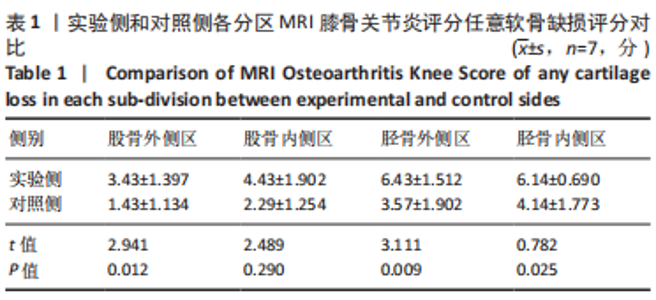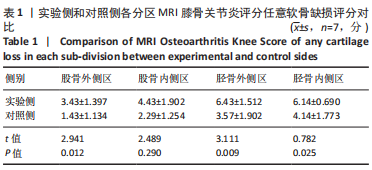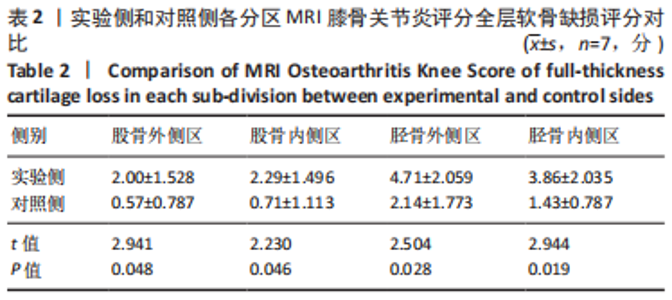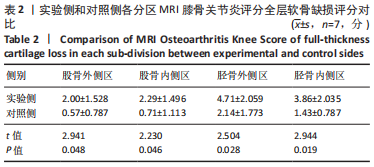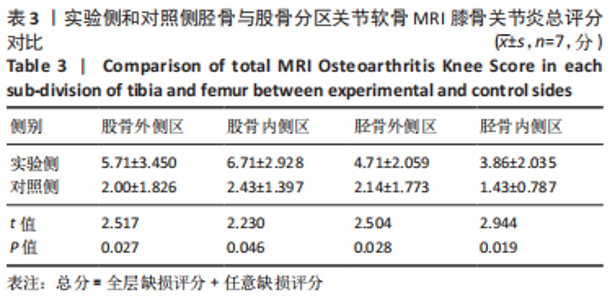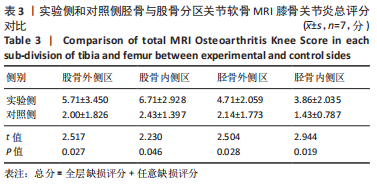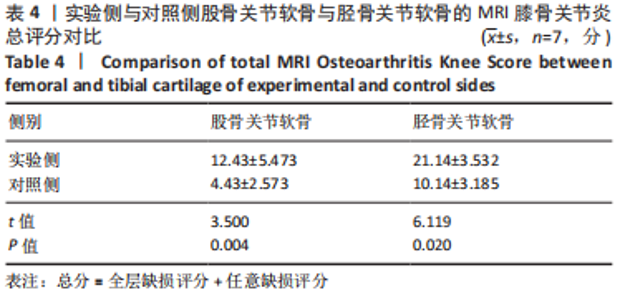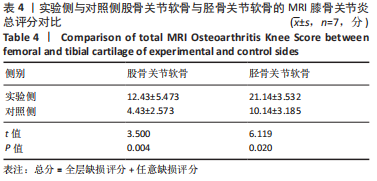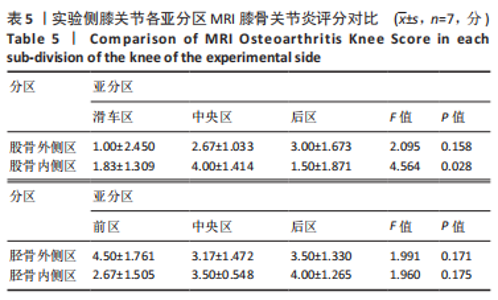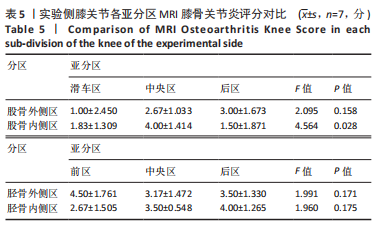[1] 陈艳平,陈蓓,郑英杰,等.膝关节骨性关节炎诊断的研究进展[J].湖南中医杂志,2017,33(5):189-193.
[2] 杨光月,郭海玲,李涛,等.磁共振技术评估膝关节软骨退变研究进展[J].中国骨伤,2016,29(11):1061-1067.
[3] HANGAARD S, GADE JS, HANSEN P, et al. Single- vs. double-dose gadolinium contrast in delayed gadolinium-enhanced MRI of cartilage (dGEMRIC) in knee osteoarthritis: is dose reduction possible on 3-T MRI? Acta Radiol. 2019;60(6):749-754.
[4] AKHADRAH RSA, REDA AM. Quantitative T2 mapping of glenohumeral joint osteoarthritis: a case-control study. Egy J Radiol Nucl Med. 2020. doi: 10.1186/s43055-020-00208-z
[5] ZIBETTI MVW, SHARAFI A, OTAZO R, et al. Accelerated mono‐ and biexponential 3D‐T1ρ relaxation mapping of knee cartilage using golden angle radial acquisitions and compressed sensing. Magn Reson Med. 2020;83(4):1291-1309.
[6] PETERFY CG, GUERMAZI A, ZAIM S, et al. Whole-Organ Magnetic Resonance Imaging Score (WORMS) of the knee in osteoarthritis. Osteoarthritis Cartilage. 2004;12(3):177-190.
[7] HUNTER DJ, LO GH, GALE D, et al. The reliability of a new scoring system for knee osteoarthritis MRI and the validity of bone marrow lesion assessment: BLOKS (Boston Leeds Osteoarthritis Knee Score). Ann Rheum Dis. 2008;67(2):206-211.
[8] HUNTER DJ, GUERMAZI A, LO GH, et al. Evolution of semi-quantitative whole joint assessment of knee OA: MOAKS (MRI Osteoarthritis Knee Score). Osteoarthritis Cartilage. 2011;19(8):990-1002.
[9] ROEMER FW, GUERMAZI A, TRATTNIG S, et al. Whole joint MRI assessment of surgical cartilage repair of the knee: Cartilage Repair OsteoArthritis Knee Score (CROAKS). Osteoarthritis Cartilage. 2014; 22(6):779-799.
[10] 韩鹏飞. 前交叉韧带重建术后膝骨关节炎小型猪模型的建立及其发病机制的研究[D]. 太原:山西医科大学,2019.
[11] 李鹏翠,王春芳,李鹏花,等.猪前交叉韧带重建联合髌骨脱位关节炎模型的分析[J].中华实验外科杂志,2020,37(11):2046-2049.
[12] 谭启钊,牛国栋,赵振达,等.关节软骨与软骨下骨改变在不同骨关节炎动物模型中的特点[J].中国实验动物学报,2019,27(4): 450-455.
[13] 刘振龙,满振涛,张继英,等.利用HHGS和OOCHAS评分评价兔前交叉韧带断裂后膝骨关节炎软骨损伤程度的研究[J].中国运动医学杂志,2015,34(02):103-110.
[14] 李志强,高丽兰,司雲朋,等.滚压载荷下有无缺损关节软骨的力学性能研究[J].中国组织工程研究,2018,22(35):5631-5636.
[15] 钟灵钗,杨大庆.MRI检查对节炎软骨损伤不同区域T_2值评估效果[J].浙江创伤外科,2020,25(1):78-79.
[16] 王海燕.高频超声与MRI在膝关节骨性关节炎诊断中的应用价值[J].医疗装备,2020,33(15):24-26.
[17] 尚卫国,谭沛.超声与MRI鉴别诊断退行性膝关节炎与类风湿性膝关节炎的价值[J].海南医学,2019,30(18):2408-2412.
[18] 储开昀,王雅婷,刘雪梅.肌肉骨骼超声与MRI检查对类风湿膝关节炎诊断的对比研究[J].中国超声医学杂志,2021,37(2):204-206.
[19] 王斌,任占丽,于楠,等.MRI评估膝关节骨性关节炎病变[J].中国医学影像技术,2020,36(9):1383-1387.
[20] 徐菲,杨志杰.磁共振T2-mapping成像在早期踝关节骨性关节炎诊断中的应用价值探析[J].中国医学计算机成像杂志,2020,26(4): 339-343.
[21] 吴楠,郅新,赖云耀,等.磁共振膝关节骨关节炎MOAKS评分在中国人群中的应用[J].中国医学影像学杂志,2016,24(4):312-315+320.
[22] 甘浩然,程楷,赵文胜,等.膝骨关节炎中骨性力线改变的影像学及临床研究[J].实用骨科杂志,2019,25(8):709-712+723.
[23] 王波,余楠生.膝骨关节炎阶梯治疗专家共识(2018年版)[J].中华关节外科杂志(电子版),2019,13(1):124-130.
[24] 王度,张文明.膝关节骨性关节炎的分型进展及临床意义[J].中国矫形外科杂志,2020,28(1):53-57.
[25] 蒋彦龙. 缺损关节软骨损伤演化力学机制的数值研究[D].天津:天津理工大学,2017.
[26] JYOTI A. Effectiveness of Platelet-rich Plasma in Knee Osteoarthritis. Indian J Public Health Res Dev. 2019.
[27] 宋沙沙,岳寿伟,Shimomura K,等.间充质干细胞在修复膝关节软骨损伤中的应用[J].中国康复,2018,33(6):518.
[28] HSU YK, SHEU SY, WANG CY, et al. The effect of adipose-derived mesenchymal stem cells and chondrocytes with platelet-rich fibrin releasates augmentation by intra-articular injection on acute osteochondral defects in a rabbit model. Knee. 2018;25(6):1181-1191.
[29] KENNEDY MI, WHITNEY K, EVANS T, et al. Platelet-Rich Plasma and Cartilage Repair. Curr Rev Musculoskelet Med. 2018;11(4):573-582.
[30] 陈兴真,段国庆.膝关节软骨损伤的手术治疗进展[J].济宁医学院学报,2020,43(6):432-436.
[31] 张永强,汪洋,鲁斌,等.关节镜下微骨折术治疗中青年膝关节软骨缺损[J].中国矫形外科杂志,2020,28(24):2287-2289.
[32] 鲁锐,游洪波.骨软骨移植技术的临床应用进展[J].华中科技大学学报(医学版),2015,44(6):737-740.
[33] 李小敏,曲扬,张少霆,等.人工智能技术在骨肌系统影像学方面的应用[J].上海交通大学学报(医学版),2021,41(2):262-266.
[34] 石松源,彭志辉.运动性软骨损伤的问题及潜在性治疗方案[J].中国组织工程研究,2019,23(31):5059-5064. |
